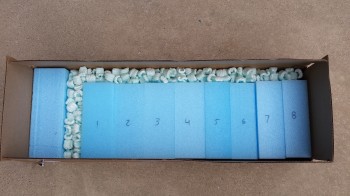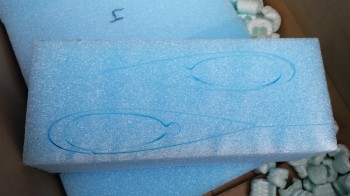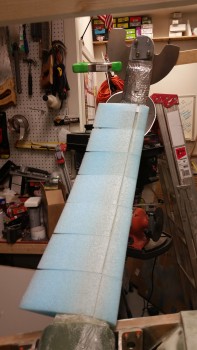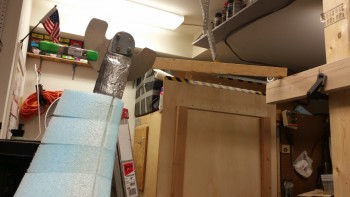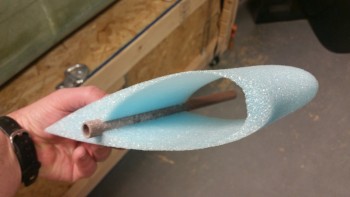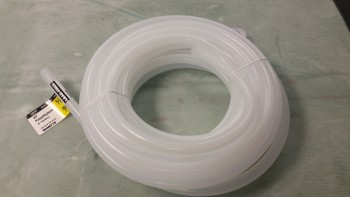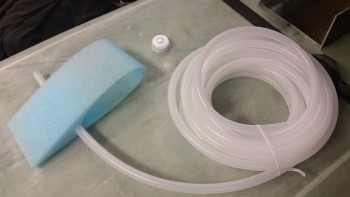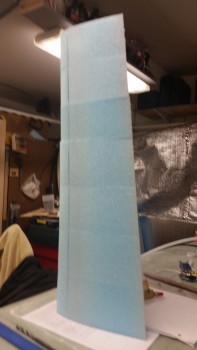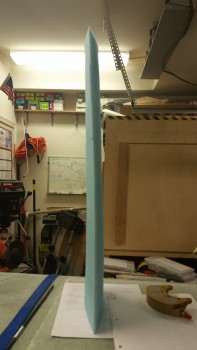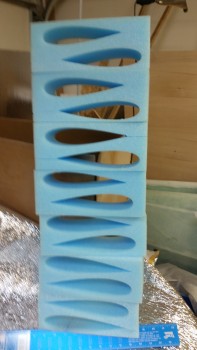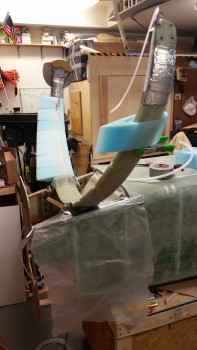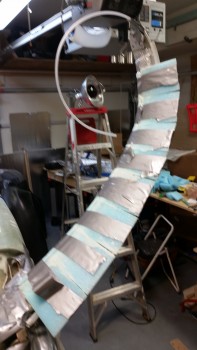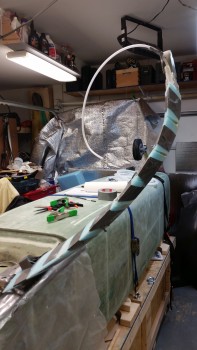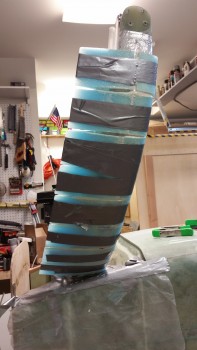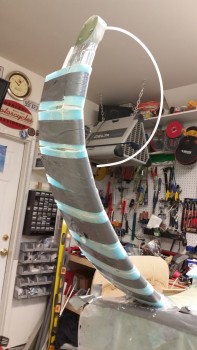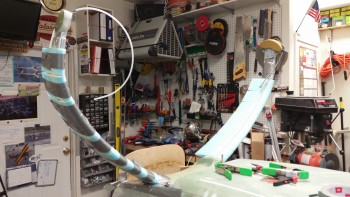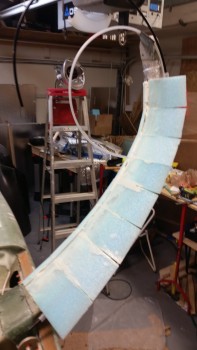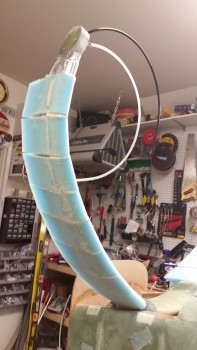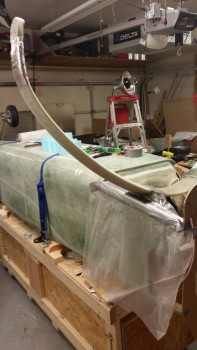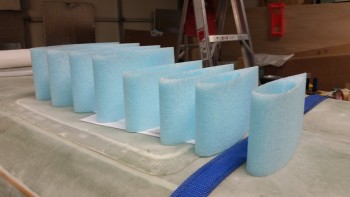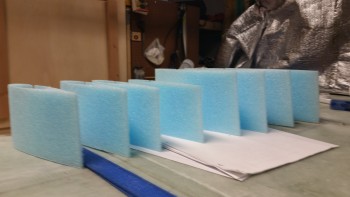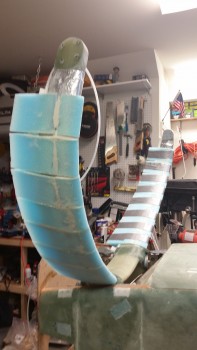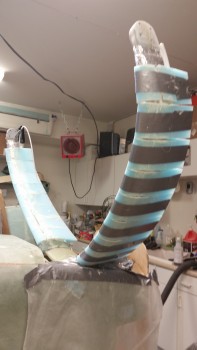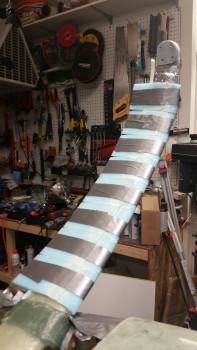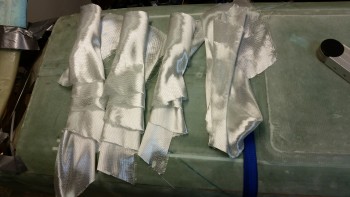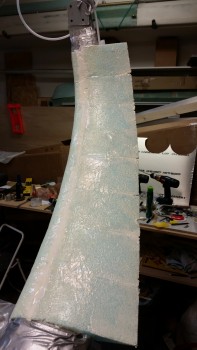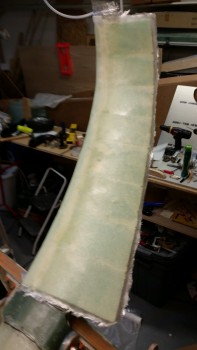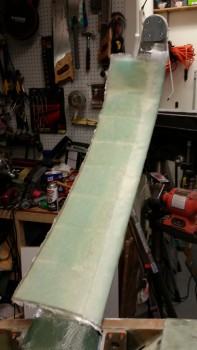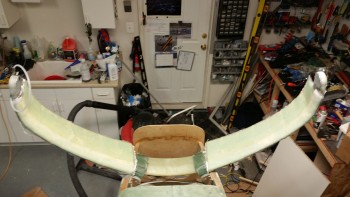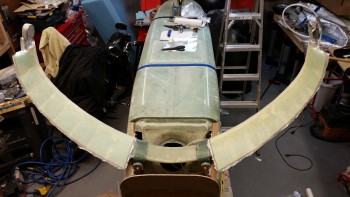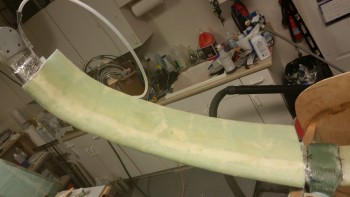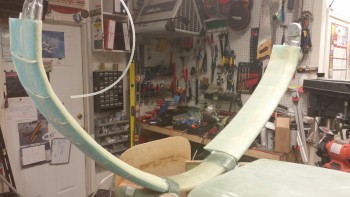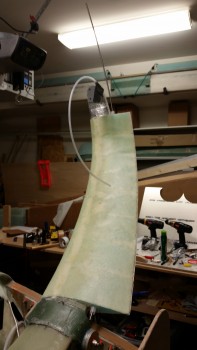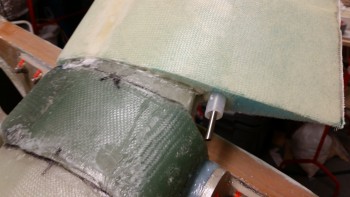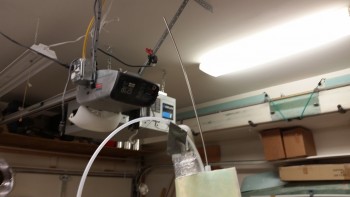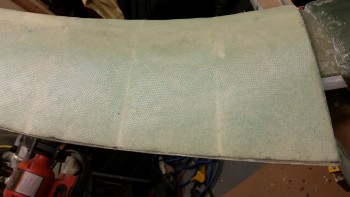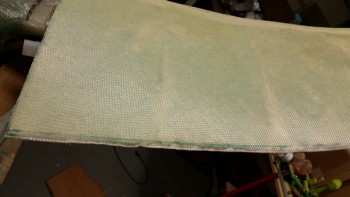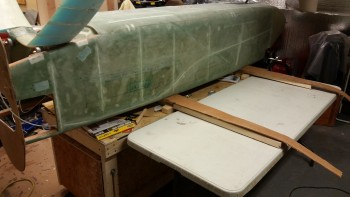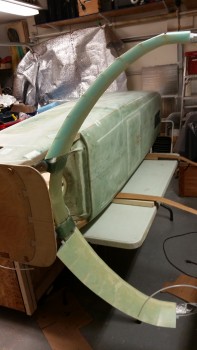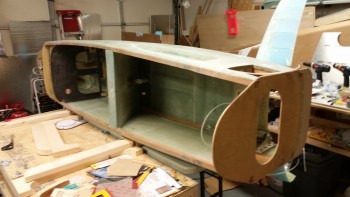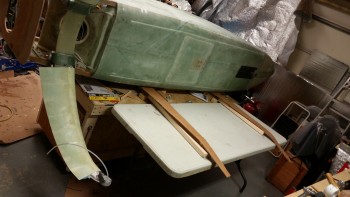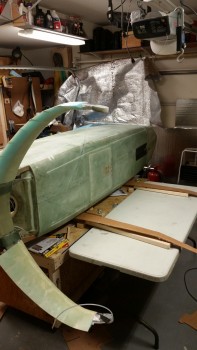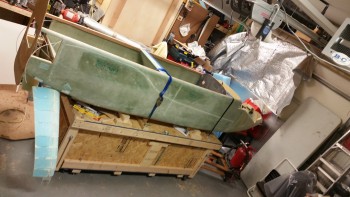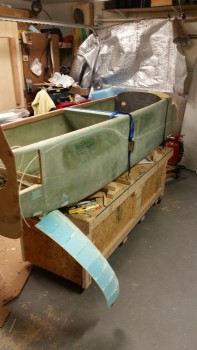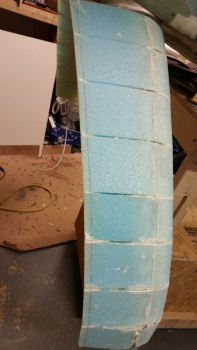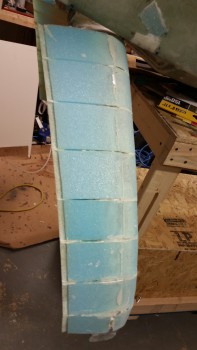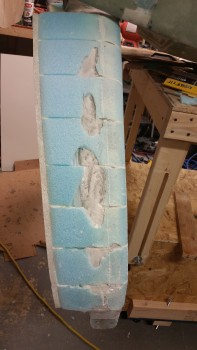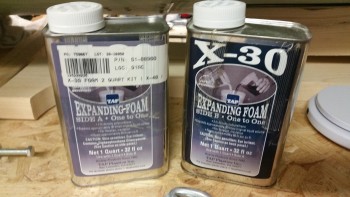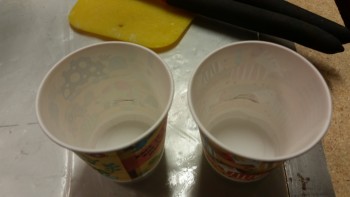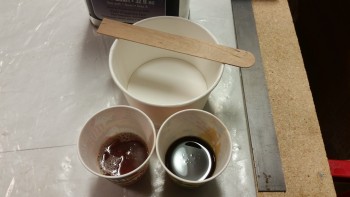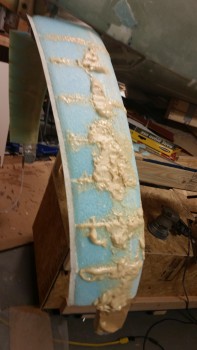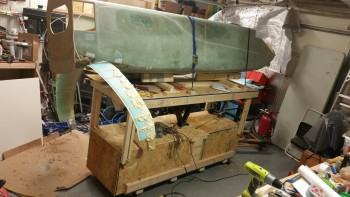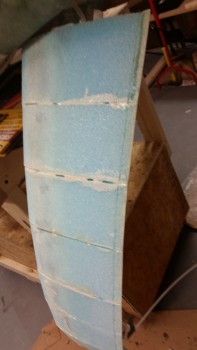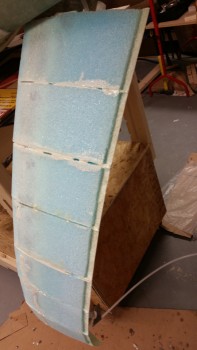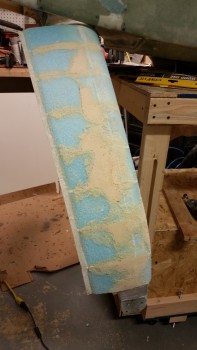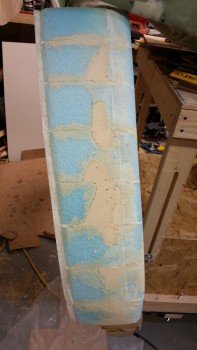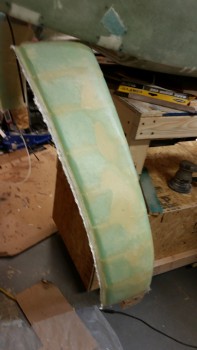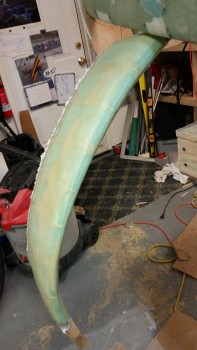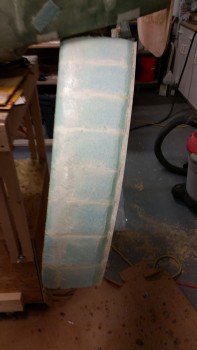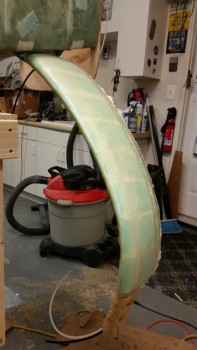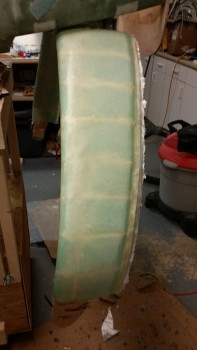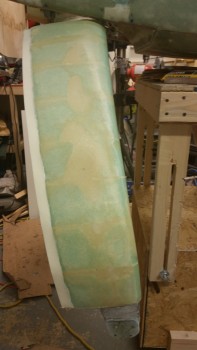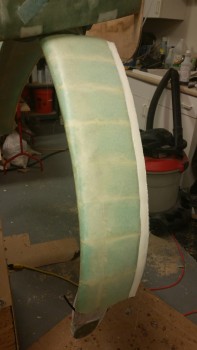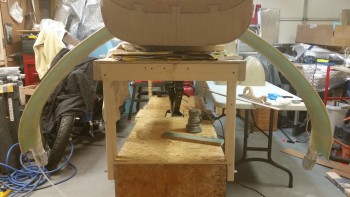Chapter 9 — Main Landing Gear Fairings
This page covers the main gear aerodynamic fairings that are installed to reduce gear leg drag. In the past, these gear fairings were often known as “Wortmann Gear Fairings.”
3 November 2014 — Today I received my Main Landing Gear Fairings from Steve at Eureka CNC. Although I got a delivery confirmation from FedEX an hour before I got home, the box was nowhere to be found. Apparently FedEx delivered them to the wrong house, requiring me to go on a 45-minute goose chase for my box. My neighbors let me know that was a common occurrence so I eventually found them at the house at the end of the street!
These gear fairings are often called “Wortmann” gear fairings, and as I’m sure most of you know they solve a big drag problem on the Long-EZ by streamlining the main gear in two ways: First, it takes the oval shape of the main gear and converts it into an airfoil shape, which is exponentially more aerodynamic than virtually any other shape. Second, it twists the gear’s angle of incidence so that it meets the oncoming air straight on and fixes the stock gear’s offset profile (read “dirty”) which creates a lot of drag.
After the delivery drama was over I opened the box to find some very precisely (of course!) hot-wired gear fairings!
I can’t wait to get these babies glassed onto the main gear. Thanks Steve!
•••
14 February 2016 — Today I figured I would check out the foam gear fairing I have on hand from Eureka CNC. On the Eureka CNC website there’s an example of the gear fairing kit install, but it’s for a Cozy. Well, the Cozy gear fairing foam pieces come in halves, whereas the Long-EZ gear fairings come as a single piece with a single slit across the thin underside of each piece. If there’s a way to get the gear fairing pieces on or off without cutting them, I honestly don’t see it. What this means is that I need to install the gear fairings before doing the final install on the axles, brakes, wheels & heat shields.
Here’s another shot of the right side toe-in setting. As for the gear fairing shown below, there’s one more piece that I wasn’t able set in place due to the thickness of the Fiberfrax. When I do install that last fairing piece I’ll have to reshape the foam on the inside of the fairing piece for it to fit.
•••
17 February 2016 — Today I went to work on widening the 7/16″ diameter channel in the gear fairing foam pieces to 1/2″ in diameter. I started with the 1/4″ round screwdriver looking Perma-Grit tool to widen the beginning of the channel out to about a 1/2″, then I switched to the 1/2″ round abrasive tool that you see in the pic below.
This is to allow for the emplacement of the 1/2″ diameter thinner walled plastic tubing that I picked up at Home Depot.
After sanding out the channel, I tested the 1/2″ diameter tubing and it fit great.
Just for fun & to see it’s “natural” shape, as I finished enlarging each gear fairing piece channel to 1/2″, I stacked them up on top of the fuselage. Since the edges are very close to matching you can see a bit of a washout in the second pic. BTW, I couldn’t get the very last fairing piece to balance without the whole tower crashing down.
Of course then I had to take a pic of the other tower I had created as I removed each foam fairing piece from its original block.
I then mocked up the first left gear fairing piece and once I figured out the starting point & marked it, I whipped up some old MGS 335 epoxy (to use it up) and made a bunch of micro with it. Below I had just painted the inboard half of the gear leg with pure epoxy before I started applying the micro.
Jumping ahead, to keep the foam pieces tight on the gear leg I used duct tape to keep the two “halves” together. However, since the tape I was using wasn’t sticking well, I carefully wrapped the duct tape around the TE and secured the tape back onto itself, on all but one fairing piece. This method secured the foam to the gear leg just tight enough.
A couple other notes on the install. First off, I would like to remind everyone that there are NO instructions that come with these gear fairings! However, that being said, I will give HUGE props to Stephen James from Eureka CNC in that once I secured these fairing pieces tightly to the gear leg, they fit so spot on that the TE of the fairing pieces aligned so well that I had no need to use the clothesline pins that I spent a good 10 minutes looking for. Very impressive.
In addition, I mentioned previously that I needed to install these now since, unlike the Cozy version, these Long-EZ gear fairing foam pieces are cut in a single piece with a slit on the inner gear side. However, on piece #5 I accidentally snapped it in half while sliding it into place. It was then that I serendipitously realized that it was actually much better to mount these in 2 pieces since you can get more micro slathered on to all the surfaces. This makes sense since instead of applying micro to the gear leg, then pushing it out of the way by sliding these pieces into place, if you simply install the front half in from the front, it captures the existing surface micro in place and keeps it in-between the gear leg and the foam fairing piece. However, while there is a bit more room to get more micro in play on the aft side, by sliding the piece into place with the tube in the channel, the aft side is still a bit tricky to get all the micro in there for a really uniform application. Thus, on the right side I will be cutting all the foam fairing pieces into 2 pieces before mounting them to the gear leg.
Here’s a wider angle shot of the gear legs showing the left gear fairing micro’d in place.
The shots below are a couple of hours later after I just carefully removed the duct tape securing the left gear leg foam fairing pieces in place. You can see that I cut the ends of the 1/2″ channel tubing and ran another narrower black tube down the middle to test clearance and accessibility. The tube works like a champ and I’m very happy with it. BTW, the fast hardener on the MGS 335 kicks off much more quickly than the fast hardener on the MGS 285, so the micro in these pics was completely cured.
•••
18 February 2016 — I started out by prepping the right gear leg for attaching the gear fairing foam pieces.
I figured I would snap a couple of shots of the gear fairing foam pieces ready to install.
I then slathered up the right gear leg with micro as I did the left site and attached all the foam fairing pieces to the gear leg.
Here’s another shot of the right side gear fairing.
I then cut 2 pieces of UNI at a 30° bias for each side, for a total of 4 pieces of UNI each measuring 11″ wide x 32″ long.
After getting all the UNI cut I mixed up some micro using MGS 335 and applied it to the bottom surface of the left gear fairing.
I then laid up 2 plies of UNI, with the 30° bias going in opposite directions.
I then micro’d the surface & laid up 2-plies of UNI on the bottom side of the right gear fairing.
Here are a couple of shots of the glassed bottom side of the gear fairings. Again, I’ll layup the top side of each gear fairing after I flip the fuselage over back upright.
•••
19 February 2016 — I didn’t get a lot done today on the plane build, but I did spend a couple of hours cleaning up the gear fairing layups from last night.
I started by pulling the 2″ wide peel ply off the LE of both sides of the fairings. I cleaned up the peel ply boogers and then cleaned up the top & bottom fairing edges by trimming away the excess glass with the Fein saw. I then cut the glass on the LE with the Fein saw using the protective duct tape edge as a guide. I didn’t take any pics of this until after I finished taping the cut line along the fairing TE with blue painters tape. I then cut both TE edges and cleaned up the LEs & TEs with my sanding board.
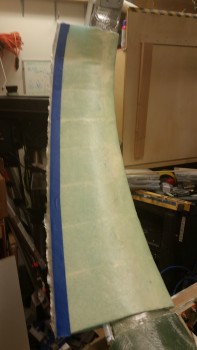
Here’s a shot of left side gear fairing LE. You can see all the other edges have been trimmed & cleaned up as well.
A shot of the gear fairings after getting trimmed & cleaned up.
•••
21 February 2016 — My main focus today was to get down to brass tax to answer my #1 burning question at the moment concerning my final brake line connections: stainless steel or Nylaflow? (both of which I have on hand). What I don’t have on hand is a flaring tool for the 3/16″ stainless steel tubing I have on hand ($$) or the fittings I would need to connect up the Nylaflow into my current configuration ($).
The first thing I needed to find out is if the stainless steel tubing would even fit into the channel tubing I emplaced on the aft side of the main gear fairings. Well, the stainless steel tubing, being a small diameter, was easily bent by hand and with just a little bit of effort & cajoling I got it to slide into the fairing channel.
Below is a closer view of the inboard side.
Knowing that the stainless steel brake line can be fit into place easily enough, I then pulled the trigger and ordered yet another tube flaring tool that can handle flaring 3/16″ stainless steel tubing. I don’t have the model or specs in front of me but when I get it in hand & use it I’ll give you a report on how it works.
Below is a shot of the outboard side gear with the stainless steel brake line sticking out. As you can see, there’s plenty of tubing to work with which will allow me to most likely create a service & anti-stress spring loop at the hell hole side of the tubing.
•••
24 February 2016 — As I mentioned in my project update, I decided that I needed to flip the fuselage right side up to glass the top sides of the gear fairing. I hadn’t planned on flipping the fuselage for quite a while, but plans change when one (read: ME) fails to account for issues such as the heat shields blocking access to the lower outboard gear leg thus preventing glassing the topside gear fairing if the wheels are mounted. Sequencing is key in my opinion for optimizing the build schedule, but in this case there was no way around it: the fuselage was going to have to get flipped back upright.
No big deal of course. I did re-wicker my build steps though to account for the fuselage being right side up. The plan now is to glass the top of the gear fairings, then do a final check & possible tweak of the toe-in, and then mount the wheels/tires/axles/brakes/heat shield. With the wheels in place, and the fuselage upright, I can then mount the wheel pants and be finished with all things gear related except for finalizing the brake line install. As for the stainless steel brake line install, the new timeline works out fine since my stainless steel capable flaring tool won’t be here for another couple weeks.
So I started off today by trimming the TE of both the right & left gear fairings.
Once I got the gear fairing TE squared away, I needed to flip the fuselage. I did about 10 minutes of head scratching before I finally remembered that I had designed the fuselage dolly so that it could match up height-wise with my portable fold out table. I set the table as you can see below and it matched up great after I set a couple 2x4s with cardboard protectors in place to get the heights equal & matched.
I then very carefully & slowly tipped over the fuselage onto the foldout table using the gear legs as a lever.
Here’s a shot from the inside cockpit side… something I haven’t seen in while.
I then slid the fuselage sideways back onto the fuselage dolly.
And then flipped the fuselage right side up back onto the fold out table, and then once again slide it over onto the fuselage dolly. Once I had it blocked correctly underneath, I then reattached the securing straps.
Another shot of the flipped fuselage from the aft end.
Clearly the bottom side of the gear is close to the ground, someplace that I don’t want to spend a lot of time messing around trying to layup glass. Luckily my fuselage dolly elevates!
Interestingly, with the amount of weight that my fuselage is packing on, my drill couldn’t handle the torque of getting the dolly platform to raise. Actually, I should say that my hand couldn’t handle the torque of the drill wanting to rip out of my hand. So I grabbed a ratchet speed handle and raised the platform its first few inches manually before switching to the drill. [I guess this demonstrates the torque required on the nose gear that Jack discusses in his instructions: to have the gear up at least a foot before climbing in & having it raise passengers from the flat deck position.]
As you can see, I raised the platform its full height giving me (and thus my back!) a much better working height for glassing the top side of the gear fairings.
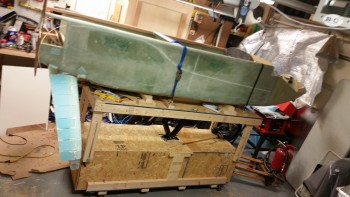 With the gear height at an acceptable working height, I then marked the right gear fairing a half inch (0.5″) forward of the TE. This will allow for a good top fairing glass to lower fairing glass bond.
With the gear height at an acceptable working height, I then marked the right gear fairing a half inch (0.5″) forward of the TE. This will allow for a good top fairing glass to lower fairing glass bond.
I used a razor knife to remove the foam, and then the Dremel Tool to remove the micro that had oozed out the aft end of the foam piece junctions. I also cleaned the dead foam & micro off the freshly exposed TE lip.
Then came the not so fun step. For some weird reason the “2-piece clamping method” that I used on the right side fairing didn’t work so well. I could run my hand up & down the outer surface of the right fairing and depress the foam inwards towards the original gear. Clearly there were a fair number of air gaps between the applied micro layer and the foam fairing pieces on the right side fairing.
With the size of the air pockets the practical solution was far beyond injecting epoxy or anything else under the foam pieces, I was going to have do a sort of rebuild on this fairing.
Enter X-30 Expanding Foam. I know a lot of builders have used this foam for a variety of things, but I personally haven’t used it before.
After reading the directions I decided that I would heed the warning of so many builders before me that this stuff really does expand 30 times its initial volume. With this in mind I marked equal pencil lines in 2 small cups less than an inch up for parts A & B of the X-30 foam.
I poured the part A & the part B X-30 foam in the separate small cups, and then as per instructions mixed them in the larger cup.
For those not familiar with the X-30 Expanding Foam, it has a 15-20 second mix time before its immediately poured and/or applied to the surface. I didn’t set up any dams or anything since I applied it straight to the surface of the right gear fairing.
Here’s a wide angle shot of the right gear faring with the expanding pour foam applied to it.
While I let the expanding foam cure some I went to work on the TE of the left gear fairing. As with the right gear fairing I trimmed the foam 0.5″ from the TE.
After finishing trimming the TE on the left side, I turned my sights back onto the right side gear fairing. I started out using the Stanley Surfoam grater to trim the foam down (left pic) and then used my sanding board to finalize the foam sanding (right pic).
I then cut another 4 pieces of UNI off the roll. This time around I added a half inch to make the width 11-1/2″ wide vs the underside 11″ wide. I cut the UNI at a 30° angle across the entire roll.
I then mixed up some flox and applied it to the left top gear fairing foam & glass junctions at both the LE & TE. I then micro’d the surface of foam gear fairing before laying up 2 plies of UNI oriented in opposite 30° angles. I overlapped the 2 plies of UNI onto the bottom fairing glass by about 1.5″ the entire length of the LE.
A front shot of the glassed topside left gear fairing.
With the right gear fairing glassed I then sanded down the blue foam & cleaned up the micro on the left fairing with the Dremel tool. Once the fairing surface was prepped, I micro’d the top left gear fairing.
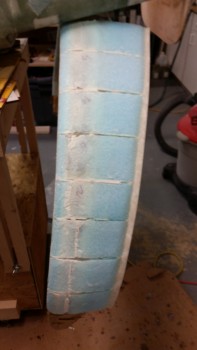
I then laid up 2 plies of UNI at opposite 30° bias just as I did on the right side gear fairing.
After laying up the UNI on the fairing I ensured that it was trimmed on both sides. I also peel plied the UNI overlap onto the lower fairing glass on each side.
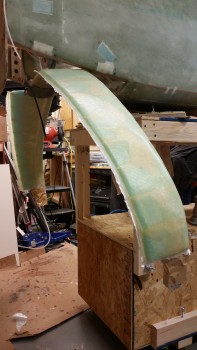
Since I used MGS 335 with slow hardener, I have a few hours before I’ll razor cut the overhanging glass. When the layup gets to that green point I’ll also apply dry micro to the depression along the TE.
•••
25 February 2016 — I started out this morning by whipping up some thick micro and applied it to the trough along the TE on both gear fairings. I then peel plied the micro with 1″ wide peel ply tape.
Later on in the afternoon I razor trimmed the TE on each side. Then in the evening I pulled all the peel ply both off the cured TE micro and the off the topside UNI overlap onto the lower UNI skin. I then sanded the aft fairing TE on each side.
This concludes the official install of the gear fairing!
•••

